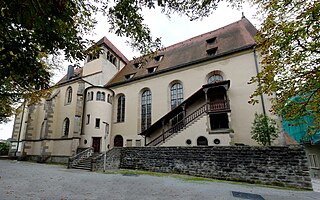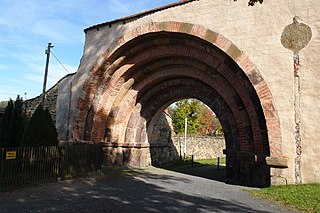
Lichtenthal Abbey (German : Kloster Lichtenthal) is a Cistercian nunnery in Lichtenthal in the town of Baden-Baden, Germany.

Lichtenthal Abbey (German : Kloster Lichtenthal) is a Cistercian nunnery in Lichtenthal in the town of Baden-Baden, Germany.
The abbey was founded in 1245 by Irmengard bei Rhein, widow of Margrave Hermann V of Baden, whose body she had brought here in 1248 from Backnang Abbey for re-burial. [1] She seriously over-reached herself financially on the project, however, and was obliged to ask her family for help.
The imposing gateway, built in 1781, leads into a three-sided walled courtyard with a fountain dedicated to the Blessed Virgin Mary, surrounded by the various abbey and domestic buildings, the school, the abbey church, the Prince's Chapel and the hermit's chapel.
The Gothic abbey church, of which the choir dates from the 14th century and the nave from the 15th, contains works of art and furnishings of many dates, particularly of the 15th century, as at this time, on the initiative of the Abbess Margaret of Baden, the church interior was lavishly refurbished and ornamented.
The Prince's Chapel was built in 1288, and until 1372 was the burial place of the Margraves of Baden. Here is also the tomb of the foundress, Margravine Irmengard. Besides the tombs, the high altar and several side altars, this chapel also contains the statue of the "Madonna of the Keys", so called because in times of danger the abbey keys are entrusted to her. (The abbey has until now survived every danger unscathed, as is related in a Baden-Baden drinking song).
The three statues over the gateway are from the nearby ruined All Saints' Abbey and represent Saint Helena, above, Abbot Gerung, first abbot of All Saints, to the left, and his mother and the foundress of All Saints, the Duchess Uta of Schauenburg, to the right, who was a relative of the Margravine Irmengard.
The hermit's chapel, built in 1678, is used as a mortuary chapel for the nuns.
The abbey belongs to the Mehrerau Congregation. The present abbess is Mother Maria Bernadette Hein, the 46th abbess since its foundation. She succeeded Mother Adelgundis Selle in 2001.
The nuns particularly devote themselves to teaching - the nunnery accommodates the primary school of Lichtenthal - and to religious handicrafts.

Godstow is a hamlet about 2.5 miles (4 km) northwest of the centre of Oxford. It lies on the banks of the River Thames between the villages of Wolvercote to the east and Wytham to the west. The ruins of Godstow Abbey, also known as Godstow Nunnery, are here. A bridge spans the Thames and the Trout Inn is at the foot of the bridge across the river from the abbey ruins. There is also a weir and Godstow lock.

Nonnberg Abbey is a Benedictine monastery in Salzburg, Austria. Founded c. 712/715 by Saint Rupert of Salzburg, it is the oldest continuously existing nunnery in the German-speaking world. The monastery complex is today a protected monument and part of the Historic Centre of the City of Salzburg, a UNESCO World Heritage Site since 1996.
Münsterschwarzach Abbey, is a monastery for Benedictine monks in Germany. It is located in Schwarzach am Main, a small market town at the confluence of the rivers Schwarzach and Main in north-eastern Bavaria.
Buchau Abbey, otherwise the Imperial Abbey of Buchau, was a self-ruling Imperial Estate and its abbess had a seat and vote at the Imperial Diet.

All Saints' Abbey was a Premonstratensian monastery near Oppenau in the Black Forest in Baden-Württemberg, Germany. It is located at 620 metres above sea level in the upper valley of the Lierbach.

The Abbey of Saint Pancras of Backnang, better known as Backnang Abbey, was a German monastery of canons regular founded around AD 1100 in Backnang, in the Duchy of Swabia.

Baindt Abbey, otherwise the Imperial Abbey of Baindt, was a Cistercian nunnery in Baindt in the district of Ravensburg in Baden-Württemberg, Germany.

Herman V, Margrave of Baden ruled Verona and Baden from 1190 until his death.

Heggbach Abbey was a Cistercian nunnery in Heggbach, now part of the municipality of Maselheim in the district of Biberach, Baden-Württemberg, Germany.

Wienhausen Abbey or Convent near Celle in Lower Saxony, Germany, is a community of Evangelical Lutheran women, which until the Reformation was a Cistercian Catholic nunnery. The abbey owns significant artworks and artifacts, including a collection of tapestries and the earliest surviving example of a type of eyeglasses.

Maubuisson Abbey is a Cistercian nunnery at Saint-Ouen-l'Aumône, in the Val-d'Oise department of France. It was founded in A.D. 1236 by Blanche of Castile, Queen of France, who may have been buried there in 1252. The site is now within the north-western suburbs of Paris. The surviving buildings are listed as a monument historique.

Altzella Abbey, also Altzelle Abbey, is a former Cistercian monastery near Nossen in Saxony, Germany. The former abbey contains the tombs of the Wettin margraves of Meissen from 1190 to 1381.
Countess Palatine Irmengard of the Rhine, also known as Irmengard of Baden was Margravine of Baden by her marriage to Herman V, Margrave of Baden-Baden. She is known as the founder of the Lichtenthal Abbey, a Cistercian nunnery that has operated without interruption since 1245.
Friedrich VI, Count of Zollern, also known as Friedrich the Knight, or Friedrich the Elder, was a Count of Hohenzollern

Koenigsbruck Abbey otherwise Königsbrück Abbey was a Cistercian nunnery in the Forest of Haguenau, near Leutenheim, Alsace, Bas-Rhin, France, on the River Sauer.

Sonnefeld Abbey is a former Cistercian nunnery in Sonnefeld in Bavaria, Germany. The former abbey church, or Klosterkirche, is now an Evangelical Lutheran parish church.

Rüegsau Priory was a 12th-century Swiss monastery of Benedictine nuns in Rüegsau, in the Canton of Bern. It was dissolved in 1528 as a result of the Reformation in Switzerland.
Rottenmünster Abbey, also the Imperial Nunnery of Rottenmünster, was a Cistercian abbey located near Rottweil in Baden-Württemberg. The self-ruling Imperial Abbey was secularized in the course of the German mediatization of 1802–1803 and its territory annexed to the Duchy of Württemberg. The monastery was closed in 1850. The buildings of the former abbey now house a hospital.

Günterstal Abbey, earlier also Güntersthal Abbey, was a Cistercian nunnery that existed from 1221 to 1806 located in Günterstal, which today is a district in Freiburg im Breisgau, Germany.

Tennenbach Abbey was a Cistercian abbey in what is now the district of Freiamt in the town of Emmendingen, Baden-Württemberg, Germany. It was originally named Porta Coeli.